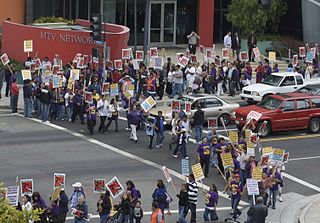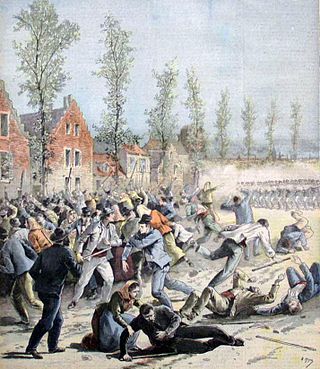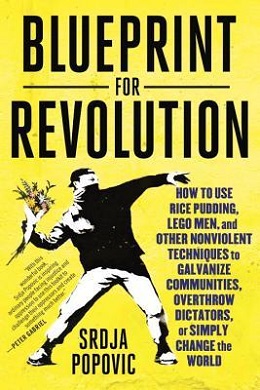Related Research Articles
Civil disobedience is the active, professed refusal of a citizen to obey certain laws, demands, orders or commands of a government. By some definitions, civil disobedience has to be nonviolent to be called "civil". Hence, civil disobedience is sometimes equated with peaceful protests or nonviolent resistance.

Satyāgraha, or "holding firmly to truth", or "truth force", is a particular form of nonviolent resistance or civil resistance. Someone who practises satyagraha is a satyagrahi.

Nonviolence is the personal practice of not causing harm to others under any condition. It may come from the belief that hurting people, animals and/or the environment is unnecessary to achieve an outcome and it may refer to a general philosophy of abstention from violence. It may be based on moral, religious or spiritual principles, or the reasons for it may be strategic or pragmatic. Failure to distinguish between the two types of nonviolent approaches can lead to distortion in the concept's meaning and effectiveness, which can subsequently result in confusion among the audience. Although both principled and pragmatic nonviolent approaches preach for nonviolence, they may have distinct motives, goals, philosophies, and techniques. However, rather than debating the best practice between the two approaches, both can indicate alternative paths for those who do not want to use violence.

A protest is a public expression of objection, disapproval, or dissent towards an idea or action, typically a political one. Protests can be thought of as acts of cooperation in which numerous people cooperate by attending, and share the potential costs and risks of doing so. Protests can take many different forms, from individual statements to mass political demonstrations. Protesters may organize a protest as a way of publicly making their opinions heard in an attempt to influence public opinion or government policy, or they may undertake direct action in an attempt to enact desired changes themselves. When protests are part of a systematic and peaceful nonviolent campaign to achieve a particular objective, and involve the use of pressure as well as persuasion, they go beyond mere protest and may be better described as civil resistance or nonviolent resistance.
The Committee for Non-Violent Action (CNVA) was an American anti-war group, formed in 1957 to resist the US government's program of nuclear weapons testing. It was one of the first organizations to employ nonviolent direct action to protest against the nuclear arms race.

The Salt March, also known as the Salt Satyagraha, Dandi March, and the Dandi Satyagraha, was an act of nonviolent civil disobedience in colonial India, led by Mahatma Gandhi. The twenty-four day march lasted from 12th March to 5th April 1930 as a direct action campaign of tax resistance and nonviolent protest against the British salt monopoly. Another reason for this march was that the Civil Disobedience Movement needed a strong inauguration that would inspire more people to follow Gandhi's example. Gandhi started this march with 78 of his trusted volunteers. The march spanned 387 kilometres (240 mi), from Sabarmati Ashram to Dandi, which was called Navsari at that time. Growing numbers of Indians joined them along the way. When Gandhi broke the British Raj salt laws at 8:30 am on 6 April 1930, it sparked large-scale acts of civil disobedience against the salt laws by millions of Indians.

Otpor was a political organization in Serbia from 1998 until 2004.
A nonviolent revolution is a revolution conducted primarily by unarmed civilians using tactics of civil resistance, including various forms of nonviolent protest, to bring about the departure of governments seen as entrenched and authoritarian without the use or threat of violence. While many campaigns of civil resistance are intended for much more limited goals than revolution, generally a nonviolent revolution is characterized by simultaneous advocacy of democracy, human rights, and national independence in the country concerned.
Civil resistance is a form of political action that relies on the use of nonviolent resistance by ordinary people to challenge a particular power, force, policy or regime. Civil resistance operates through appeals to the adversary, pressure and coercion: it can involve systematic attempts to undermine or expose the adversary's sources of power. Forms of action have included demonstrations, vigils and petitions; strikes, go-slows, boycotts and emigration movements; and sit-ins, occupations, constructive program, and the creation of parallel institutions of government.

"People Power" is a political term denoting the populist driving force of any social movement which invokes the authority of grassroots opinion and willpower, usually in opposition to that of conventionally organised corporate or political forces. People power protest attempts to make changes in the political process of a given state - it refers to “revolutions driven by civil society mobilisation” which result in a reconfiguration of political power in a given state. As denoted by the name, this method is reliant on popular participation “civilian-based” and therefore does not include isolated acts or protest without an overarching organisation by a group of people. People power can be manifested as a small-scale protest or campaign for neighborhood change; or as wide-ranging, revolutionary action involving national street demonstrations, work stoppages and general strikes intending to overthrow an existing government and/or political system. With regards to tactics employed by People Power movements, both nonviolence and violence have been used throughout history: as was the case in the non-violent 1986 Philippines revolution which overthrew the Marcos régime, or the violent uprising in Libya in 2011.

The right to protest may be a manifestation of the right to freedom of assembly, the right to freedom of association, and the right to freedom of speech. Additionally, protest and restrictions on protest have lasted as long as governments have.

Nonviolent resistance, or nonviolent action, sometimes called civil resistance, is the practice of achieving goals such as social change through symbolic protests, civil disobedience, economic or political noncooperation, satyagraha, constructive program, or other methods, while refraining from violence and the threat of violence. This type of action highlights the desires of an individual or group that feels that something needs to change to improve the current condition of the resisting person or group.
Different Muslim movements through history had linked pacifism with Muslim theology. However, warfare has been an integral part of Islamic history both for the defense and the spread of the faith since the time of Muhammad.

Srđa Popović is a Serbian political activist. He was a leader of the student movement Otpor that helped topple Serbian president Slobodan Milošević. After briefly pursuing a political career in Serbia, he established the Centre for Applied Nonviolent Action and Strategies (CANVAS) in 2003 and published Blueprint for Revolution in 2015. CANVAS has worked with pro-democracy activists from more than 50 countries, promoting the use of non-violent resistance in achieving political and social goals.
Laughtivism is strategic use of humor and mocking by social nonviolent movements in order to undermine the authority of an opponent, build credibility, break fear and apathy and reach target audiences. It has been defined, and predominantly practiced independently by two activist groups - The Center for Applied Nonviolent Actions and Strategies (CANVAS) based in Belgrade, Serbia as well as the New York-based team the Yes Men Some recent examples of Laughtivism include: The Yes Men creating a false movie production company comparing the Midwestern Tar Sands area to Mordor, and Egyptian comedian Bassem Youssef's satirical television show The B+ which made fun of events during the Egyptian Revolution in 2011.
The Centre for Applied Nonviolent Action and Strategies(CANVAS) is a non-profit, non-governmental, educational institution focused on the use of nonviolent conflict, based in Belgrade, Serbia. It was founded in 2004 by Srđa Popović and the CEO of Orion Telecom, Slobodan Đinović. Both were former members of the Serbian youth resistance movement, Otpor!, which supported the overthrow of Slobodan Milošević in October 2000. Drawing upon the Serbian experience, CANVAS seeks to educate pro-democracy activists around the world in what it regards as the universal principles for success in nonviolent struggle.
Stellan Vinthagen is a professor of sociology, a scholar-activist, and the Inaugural Endowed Chair in the Study of Nonviolent Direct Action and Civil Resistance at the University of Massachusetts, Amherst, where he directs the Resistance Studies Initiative. He is also Co-Leader of the Resistance Studies Group at University of Gothenburg and co-founder of the Resistance Studies Network, as well as Editor of the Journal of Resistance Studies, and a Council Member of War Resisters International (WRI), and academic advisor to the International Center on Nonviolent Conflict (ICNC). His research is focused on resistance, power, social movements, nonviolent action, conflict transformation and social change. He has since 1980 been an educator, organizer and activist in several countries, and has participated in more than 30 nonviolent civil disobedience actions, for which he has served in total more than one year in prison.

Direct action is a term for economic and political behavior in which participants use agency—for example economic or physical power—to achieve their goals. The aim of direct action is to either obstruct a certain practice or to solve perceived problems.

Diversity of tactics is a phenomenon wherein a social movement makes periodic use of force for disruptive or defensive purposes, stepping beyond the limits of nonviolent resistance, but also stopping short of total militarization. It also refers to the theory which asserts this to be the most effective strategy of civil disobedience for social change. Diversity of tactics may promote nonviolent tactics, or armed resistance, or a range of methods in between, depending on the level of repression the political movement is facing. It sometimes claims to advocate for "forms of resistance that maximize respect for life".

Blueprint for Revolution: How to Use Rice Pudding, Lego Men, and Other Nonviolent Techniques to Galvanize Communities, Overthrow Dictators, or Simply Change the World is a book written by Srdja Popovic, the founder of the Centre for Applied Nonviolent Action and Strategies (CANVAS). The book is described on its back cover as "a handbook for anyone who wants to effectively improve your neighborhood, make a difference in your community, or change the world."
References
- 1 2 Laura Moth, Today's Zaman, 19 June 2013, A standing dilemma in Taksim [ permanent dead link ]
- ↑ John A. Gould and Edward Moe, "Beyond Rational Choice: Ideational Assault and the Strategic Use of Frames in Nonviolent Civil Resistance", in, Sharon Erickson Nepstad, Lester R. Kurtz (2012), Nonviolent Conflict and Civil Resistance, Emerald Group Publishing, p141
- 1 2 McClennen, Sophia; Popovic, Srdja; Wright, Joseph (2023). "How to Sharpen a Nonviolent Movement". Journal of Democracy. 34 (1): 110–125. doi:10.1353/jod.2023.0007. ISSN 1086-3214.
- ↑ wri-irg.org, 5 March 2013, Freedom Flotilla to Gaza – a dilemma action evolves
- ↑ Al Jazeera, 28 April 2011, Uganda walk-to-work protests kick up dust